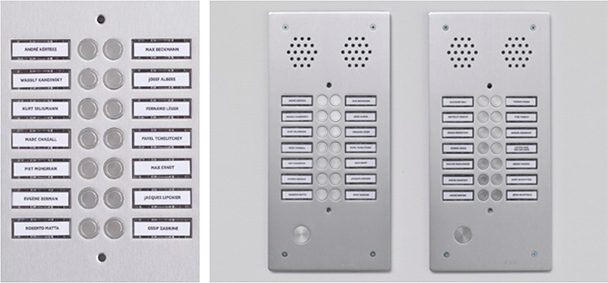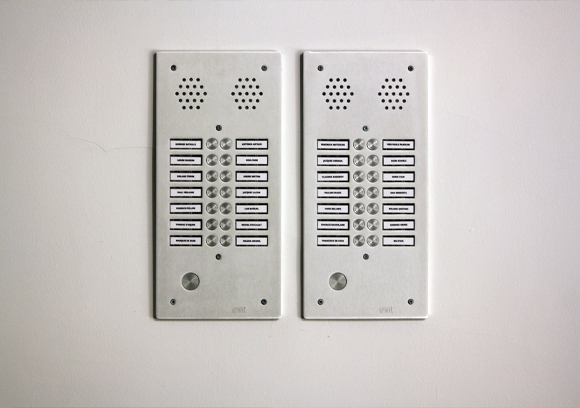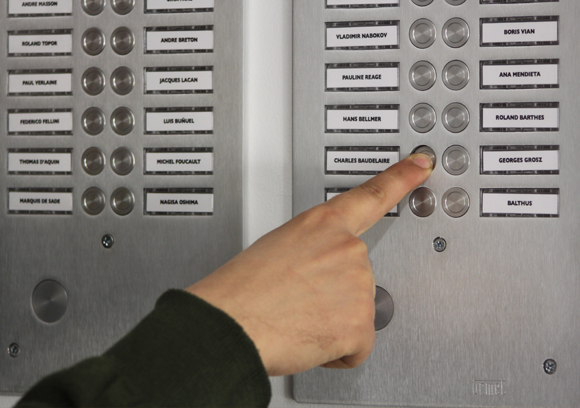| |
|
41.
 | We are here, Art in Exile
| We are here, Art in Exile |
| |

'' These readymades are attached to the wall as if they still worked, representing architectural ghosts.
These buildings, symbolized by these intercoms, bring an intellectual heritage to mind. ''
Studio Fatmi, Decembre 2016

We are here
Exhibition view from Constructing Illusion, Analix Forever, 2015, Geneva.

We are here
Exhibition view from Constructing Illusion, Analix Forever, 2015, Geneva.
|
|
2014-2015, diptych, 38,5 x 18 cm. doorbells in metal.
Exhibition view from Art in Exile, Keitelman Gallery, 2015, Brussels.
Courtesy of the artist and Ceysson & Bénétière, Paris.
|
|
|
| Collection of Galila’s P.O.C, Brussels
La série de sculptures Nous sommes ici de mounir fatmi sont des interphones où les noms d’intellectuels et d’artistes disparues sont inscrits. L’interphone prend ici une fonction toute particulière. Incarnant un portrait-robot d’un immeuble fantôme, il expose à la vue de tous l’identité de ses habitants. En dévoilant ces identités, mounir fatmi touche à diverses problématiques constitutives de son travail. Cette série, work in progress, est en perpétuelle évolution en fonction des choix des noms des différentes personnalités.
Lors de l’exposition Permanent Exiles au MAMCO en 2015, c’est autour de la figure de Claude Lévi Strauss que mounir fatmi a constitué son immeuble fantôme par la mention d’autres personnalités tel que Hannah Arendt ou encore Georges Perec, Béla Bartok, Kazimir Malevitch., Max Ernst et Theodor Adorno. Ainsi, lors de son exposition Art in Exile à la Galerie Keitelman en 2015, il choisit de mentionner des artistes européens comme André Breton, Marc Chagall, mais aussi Joseph Albers et Max Beckman. Ce choix-ci s’étant porté sur des artistes ayant connu l’exil au cours de leur vie. Enfin, en 2016, au centre d’art Labanque à Bethune, la sculpture Nous sommes ici, Confessions, des personnalités artistiques et littéraires sont réunis autour de Georges Bataille. Partageant des affinités avec ce dernier, André Masson, Roland Topor, Ana Mediate autant que Gina Pane et Federico Fellini sont représentés.
Ces ready made sont fixés au mur, comme s’ils fonctionnaient, représentent des architectures fantômes. Ces immeubles figurés par la présence de ces interphones évoquent un héritage intellectuel. Cette série se rapproche donc des divers travaux de mounir fatmi sur l’architecture comme pensée.
Le visiteur se retrouve confronté à la réunion impossible de ces fantômes. mounir fatmi tente ici de questionner les limites de la vie amenée par la survenance de la mort et propose une possibilité de vie au-delà du corps en présentant la conscience comme une alternative à la matière. Si la notion d’architecture est partie prenante de cette série, la notion de disparition est donc latente. En effet, si les personnalités et les immeubles disparaissent restent toujours le souvenir, l’idée. Si les murs tombent et les ruines disparaissent, la pensée, elle, demeure.
La série Nous sommes ici, fixée au mur s’active par la présence des visiteurs. Ceux-ci prennent alors pleine conscience de ce que cache ces interphones. Dans un premier temps par ces architectures sous-entendus par ces interphones ; et d’autre part dans l’action d’appuyer sur un bouton. En choisissant une personnalité à qui l’envie prend de s’adresser, le public développe ce lien de pensée. Ainsi se construit, telle une architecture, un nouveau mode de relation entre le visiteur et l’œuvre.
Studio Fatmi, Decembre 2016.
André Kértesz
Wassily Kandinsky
Kurt Seligman
Marc Chagall
Piet Mondrian
Eugène Berman
Roberto Matta
Max Beckmann
Joseph Albers
Fernand Léger
Pavel Tchelitchev
Max Ernst
Jacques Lipchier
Ossip Zadkine
Salvador Dali
Bertoldt Brecht
Oskar Kokoschka
George Grosz
Walter Friedländer
Erwin Panofsky
André Breton
Thomas Mann
Yves Tanguy
Amedée Ozenfant
Ludwig Mies van der Rohe
André Masson
Kurt Schwitters
John Heartfield
|
|
mounir fatmi’s series of sculptures entitled We are Here, Confessions, are intercoms onto which names of departed artists are inscribed. The interphone takes on a very particular function as it embodies a robotic portrait of a ghost building that exposes all of its inhabitants. In exposing these identities, mounir fatmi touches on various issues that he explores in his work. This series, a work in progress, is in perpetual evolution in accordance with the names of different personalities.
During the Permanent Exiles exhibit at MAMCO in 2015, mounir fatmi created his ghost building around the figure of Claude Lévi Strauss and other personalities such as Hannah Arendt, Georges Perec, Béla Bartok, Kazimir Malevitch, Max Ernst and Theodor Adorno. During his Art in Exile exhibition at the Keitelman Gallery in 2015, he chose to mention European artists including André Breton, Marc Chagall, but also Joseph Albers and Max Beckman. The artists chosen had experienced exile in their lifetime.
Finally, in 2016, at the Labanque art center in Bethune, the We are Here, Confessions installment gathered artistic and literary personalities around Georges Bataille. Sharing affinities with the latter, André Masson, Roland Topor, Ana Mediate and Gina Pane and Federico Fellini are represented.
These readymades are attached to the wall as if they still worked, representing architectural ghosts. These buildings, symbolized by these intercoms, bring an intellectual heritage to mind. This series is therefore linked to various works by mounir fatmi in terms of both architecture and thought.
The visitor is confronted with the impossible meeting of these ghosts. mounir fatmi attempts to question the limits of life through death’s occurrence, and proposes the possibility of life beyond the body by presenting consciousness as an alternative to matter. While the notion of architecture is a clear part of this series, there is an underlying notion of disappearance. Though personalities and buildings disappear, the memory and the idea will always endure. Though the walls fall and the ruins disappear, the thought still remains.
The We Are Here series is fixed to the wall and is activated by the presence of visitors. They then become fully aware of what these intercoms are hiding; First by the architecture implied by these intercoms, and then by the action of pressing a button. In choosing a personality with whom the visitor would like to speak, the public develops this line of thought. Like an element of architecture, a new type of relationship between the spectator and the work is thus created.
Studio Fatmi, Decembre 2016.
Traduit du français par Christina Washington.
André Kértesz
Wassily Kandinsky
Kurt Seligman
Marc Chagall
Piet Mondrian
Eugène Berman
Roberto Matta
Max Beckmann
Joseph Albers
Fernand Léger
Pavel Tchelitchev
Max Ernst
Jacques Lipchier
Ossip Zadkine
Salvador Dali
Bertoldt Brecht
Oskar Kokoschka
George Grosz
Walter Friedländer
Erwin Panofsky
André Breton
Thomas Mann
Yves Tanguy
Amedée Ozenfant
Ludwig Mies van der Rohe
André Masson
Kurt Schwitters
John Heartfield
|
|
|
|